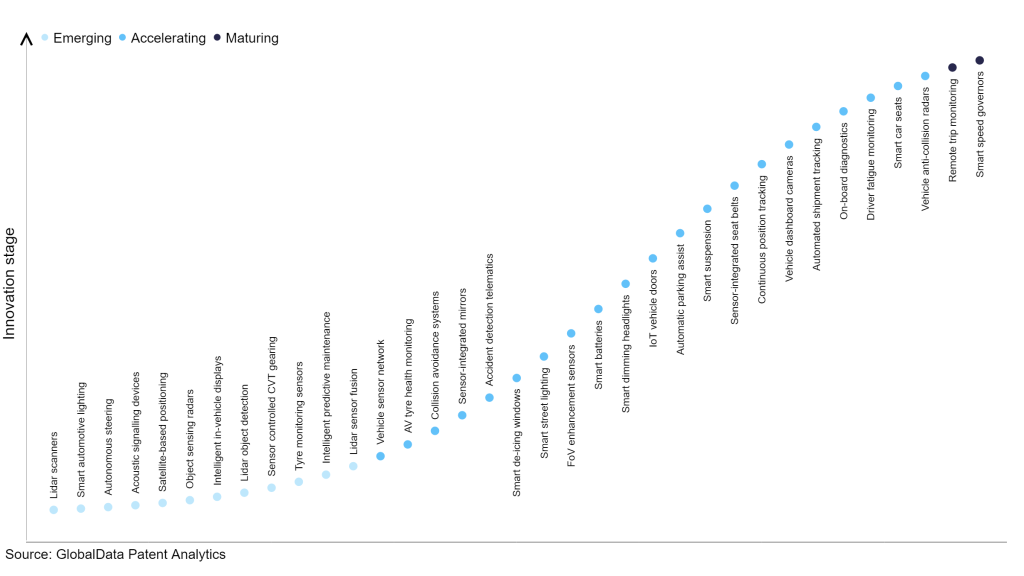The automotive industry continues to be a hotbed of patent innovation. Activity in object sensing radars is driven by improved safety in autonomous vehicles, accuracy, efficiency, and versatility in object detection and ranging technologies, and growing importance of technologies such as frequency modulated continuous wave (FMCW) radar, pulse-doppler radar, phased array radar, and synthetic aperture radar (SAR). In the last three years alone, there have been over 720,000 patents filed and granted in the automotive industry, according to GlobalData’s report on Internet of Things in automotive: object sensing radars. Buy the report here.

Discover B2B Marketing That Performs
Combine business intelligence and editorial excellence to reach engaged professionals across 36 leading media platforms.
However, not all innovations are equal and nor do they follow a constant upward trend. Instead, their evolution takes the form of an S-shaped curve that reflects their typical lifecycle from early emergence to accelerating adoption, before finally stabilizing and reaching maturity.
Identifying where a particular innovation is on this journey, especially those that are in the emerging and accelerating stages, is essential for understanding their current level of adoption and the likely future trajectory and impact they will have.
300+ innovations will shape the automotive industry
According to GlobalData’s Technology Foresights, which plots the S-curve for the automotive industry using innovation intensity models built on over one million patents, there are 300+ innovation areas that will shape the future of the industry.
Within the emerging innovation stage, autonomous steering, LiDAR scanners and intelligent predictive maintenance are disruptive technologies that are in the early stages of application and should be tracked closely. Sensor-integrated mirrors, smart street lighting and automatic parking assist are some of the accelerating innovation areas, where adoption has been steadily increasing. Among the maturing innovation areas are remote trip monitoring and smart speed governors, which are now well established in the industry.
Innovation S-curve for Internet of Things in the automotive industry

Object sensing radars is a key innovation area in Internet of Things
Object sensing radars refer to radar systems and methods that are used to sense the environment and detect objects. These radars utilize various techniques such as side-looking radar, 3D mapping, object recognition, obstacle avoidance, cooperative radar, and target detection. They enable vehicles to gather data about their surroundings, analyze it, and make informed decisions based on the detected objects. Object sensing radars play a crucial role in the development of autonomous vehicles and advanced driver assistance systems (ADAS).
GlobalData’s analysis also uncovers the companies at the forefront of each innovation area and assesses the potential reach and impact of their patenting activity across different applications and geographies. According to GlobalData, there are 770+ companies, spanning technology vendors, established automotive companies, and up-and-coming start-ups engaged in the development and application of object sensing radars.
Key players in object sensing radars – a disruptive innovation in the automotive industry
‘Application diversity’ measures the number of applications identified for each patent. It broadly splits companies into either ‘niche’ or ‘diversified’ innovators.
‘Geographic reach’ refers to the number of countries each patent is registered in. It reflects the breadth of geographic application intended, ranging from ‘global’ to ‘local’.
Alphabet is one of the leading patent filers in object sensing radars. The company has integrated various sensor technologies, including light detection and ranging (LiDAR), radars, cameras, and other sensors, for comprehensive object detection and perception. While LiDAR is often highlighted, their radar technology innovations include advancements in radar sensor design, processing, and fusion with other sensor data for a holistic perception system. Alphabet has made innovations in multi-sensor fusion techniques, combining data from different types of sensors to improve the accuracy and reliability of object detection, classification, and tracking. Th fusion helps in creating a more comprehensive understanding of the vehicle's surroundings. Some other key patent filers in this space include Infineon Technologies and Fujitsu.
In terms of application diversity, Uhnder leads the pack, while Murata Manufacturing and WGR stood in the second and third positions, respectively. By means of geographic reach, Proxy Technologies held the top position, followed by Nio and Komatsu.
To further understand the key themes and technologies disrupting the automotive industry, access GlobalData’s latest thematic research report on Internet of Things (IoT) in Automotive.
Data Insights
From

The gold standard of business intelligence.
Blending expert knowledge with cutting-edge technology, GlobalData’s unrivalled proprietary data will enable you to decode what’s happening in your market. You can make better informed decisions and gain a future-proof advantage over your competitors.





